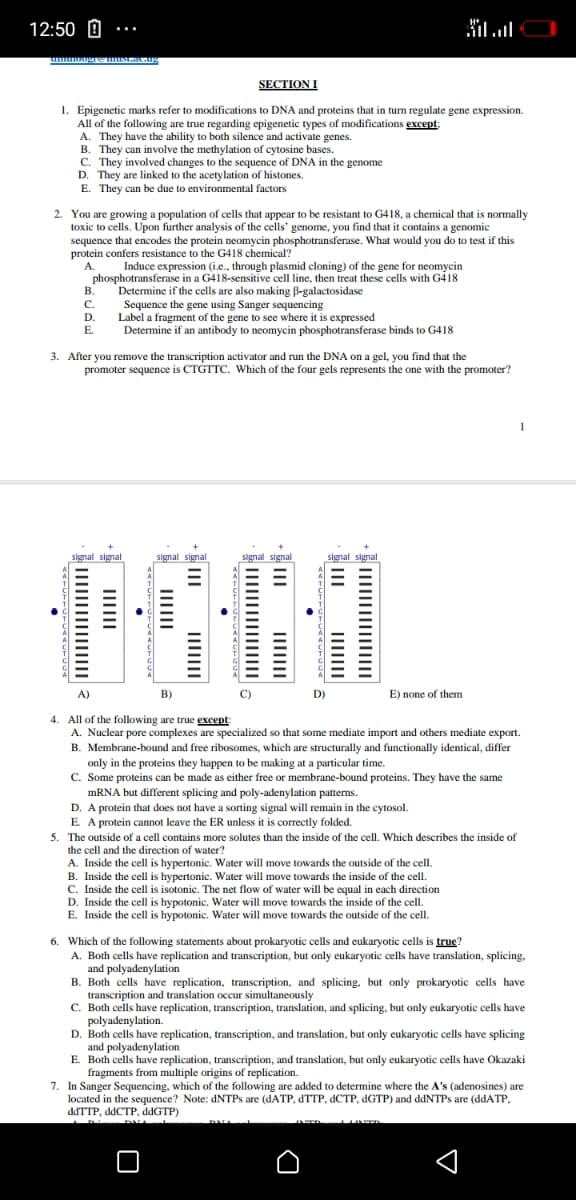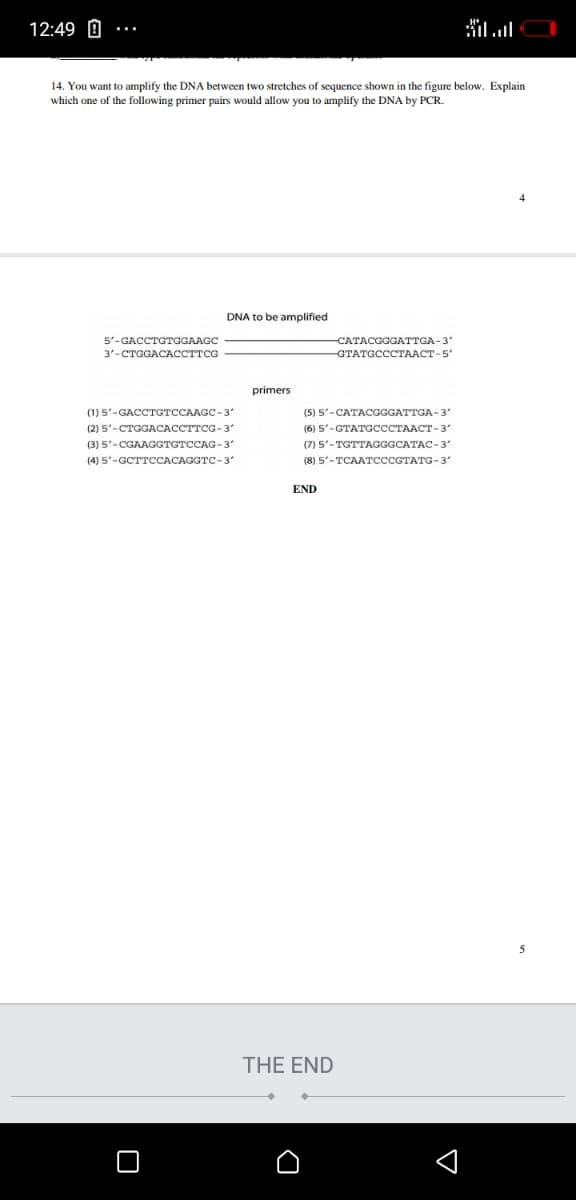1. Epigenetic marks refer to modifications to DNA and proteins that in tum regulate gene expression. All of the following are true regarding epigenetic types of modifications except: A. They have the ability to both silence and activate genes. B. They can involve the methylation of cytosine bases. C. They involved changes to the sequence of DNA in the genome D. They are linked to the acetylation of histones. E. They can be due to environmental factors
1. Epigenetic marks refer to modifications to DNA and proteins that in tum regulate gene expression. All of the following are true regarding epigenetic types of modifications except: A. They have the ability to both silence and activate genes. B. They can involve the methylation of cytosine bases. C. They involved changes to the sequence of DNA in the genome D. They are linked to the acetylation of histones. E. They can be due to environmental factors
Biology 2e
2nd Edition
ISBN:9781947172517
Author:Matthew Douglas, Jung Choi, Mary Ann Clark
Publisher:Matthew Douglas, Jung Choi, Mary Ann Clark
Chapter14: Dna Structure And Function
Section: Chapter Questions
Problem 33CTQ: What is the role of a primer in DNA replication? What would happen if you forgot to add a primer in...
Related questions
Question
100%

Transcribed Image Text:12:50 0
וח.וה
...
SECTION I
1. Epigenetic marks refer to modifications to DNA and proteins that in turn regulate gene expression.
All of the following are true regarding epigenetic types of modifications except:
A. They have the ability to both silence and activate genes.
B. They can involve the methylation of cytosine bases.
C. They involved changes to the sequence of DNA in the genome
D. They are linked to the acetylation of histones.
E. They can be due to environmental factors
2. You are growing a population of cells that appear to be resistant to G418, a chemical that is normally
toxic to cells. Upon further analysis of the cells' genome, you find that it contains a genomic
sequence that encodes the protein neomycin phosphotransferase. What would you do to test if this
protein confers resistance to the G418 chemical?
A.
Induce expression (i.e., through plasmid cloning) of the gene for neomycin
phosphotransferase in a G418-sensitive cell line, then treat these cells with G418
Determine if the cells are also making B-galactosidase
Sequence the gene using Sanger sequencing
Label a fragment of the gene to see where it is expressed
Determine if an antibody to neomycin phosphotransferase binds to G418
B.
С.
D.
E.
3. After you remove the transcription activator and run the DNA on a gel, you find that the
promoter sequence is CTGTTC. Which of the four gels represents the one with the promoter?
1
signal signal
signal signal
signal signal
signal signal
A)
B)
C)
D)
E) none of them
All of the following are true gxcept
A. Nuclear pore complexes are specialized so that some mediate import and others mediate export.
B. Membrane-bound and free ribosomes, which are structurally and functionally identical, differ
only in the proteins they happen to be making at a particular time.
C. Some proteins can be made as either free or membrane-bound proteins. They have the same
MRNA but different splicing and poly-adenylation patterns.
D. A protein that does not have a sorting signal will remain in the cytosol.
E. A protein cannot leave the ER unless it is correctly folded.
5. The outside of a cell contains more solutes than the inside of the cell. Which describes the inside of
4.
the cell and the direction of water?
A. Inside the cell is hypertonic. Water will move towards the outside of the cell.
B. Inside the cell is hypertonic. Water will move towards the inside of the cell.
C. Inside the cell is isotonic. The net flow of water will be equal in each direction
D. Inside the cell is hypotonic. Water will move towards the inside of the cell.
E. Inside the cell is hypotonic. Water will move towards the outside of the cell.
6. Which of the following statements about prokaryotic cells and eukaryotic cells is true?
A. Both cells have replication and transcription, but only eukaryotic cells have translation, splicing,
and polyadenylation
B. Both cells have replication, transcription, and splicing. but only prokaryotic cells have
transcription and translation occur simultaneously
C. Both cells have replication, transcription, translation, and splicing, but only eukaryotic cells have
polyadenylation.
D. Both cells have replication, transcription, and translation, but only eukaryotic cells have splicing
and polyadenylation
E Both cells have replication, transcription, and translation, but only eukaryotic cells have Okazaki
fragments from multiple origins of replication.
7. In Sanger Sequencing, which of the following are added to determine where the A's (adenosines) are
located in the sequence? Note: DNTPS are (DATP, dTTP, dCTP, dGTP) and ddNTPs are (ddATP,
ddTTP, ddCTP, ddGTP)

Transcribed Image Text:12:49 0
14. You want to amplify the DNA between two stretches of sequence shown in the figure below. Explain
which one of the following primer pairs would allow you to amplify the DNA by PCR.
DNA to be amplified
5'-GACCTGTGGAAGC
-CATACGGGATTGA-3"
3'-CTGGACACCTTCG
GTATGCCCTAACT-5"
primers
(1) 5'-GACCTGTCCAAGC-3
(2) 5-CTGGACACCTTCG-3
(5) 5-CATACGGGATTGA-3"
(6) 5°-GTATGСССТААСТ-3°
(3) 5'-CGAAGGTGTCCAG-3'
(7) 5'-TGTTAGGGCATAC-3"
(4) 5'-GCTTССАСАGGTC-3°
(8) 5'-TCAATCCCGTATG-3'
END
5
THE END
Expert Solution
This question has been solved!
Explore an expertly crafted, step-by-step solution for a thorough understanding of key concepts.
This is a popular solution!
Trending now
This is a popular solution!
Step by step
Solved in 3 steps

Knowledge Booster
Learn more about
Need a deep-dive on the concept behind this application? Look no further. Learn more about this topic, biochemistry and related others by exploring similar questions and additional content below.Recommended textbooks for you

Biology 2e
Biology
ISBN:
9781947172517
Author:
Matthew Douglas, Jung Choi, Mary Ann Clark
Publisher:
OpenStax

Concepts of Biology
Biology
ISBN:
9781938168116
Author:
Samantha Fowler, Rebecca Roush, James Wise
Publisher:
OpenStax College

Biology 2e
Biology
ISBN:
9781947172517
Author:
Matthew Douglas, Jung Choi, Mary Ann Clark
Publisher:
OpenStax

Concepts of Biology
Biology
ISBN:
9781938168116
Author:
Samantha Fowler, Rebecca Roush, James Wise
Publisher:
OpenStax College